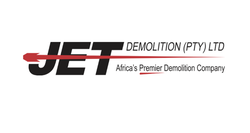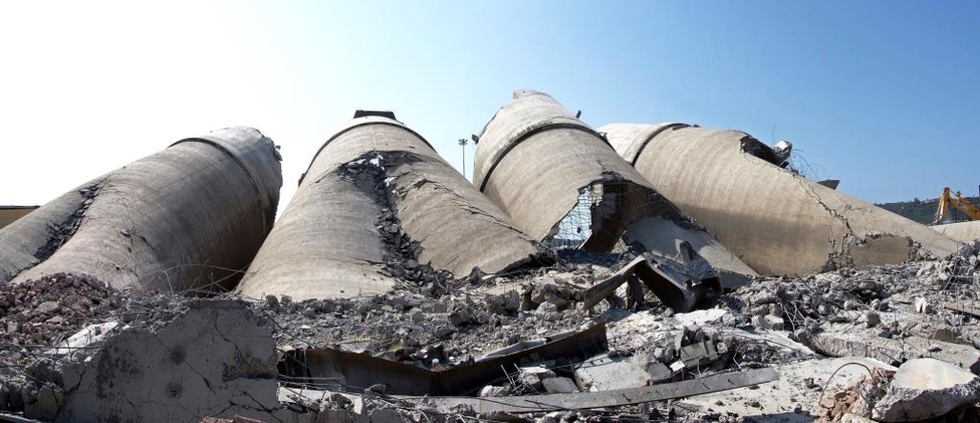Dealing with asbestos, hazardous materials at industrial and mining sites
| Dealing with asbestos hazardous materials at industrial and mining site _approved | 44.5 KB | Download | |
| Bagged and Tagged Hazardous Waste - ready for disposal. | 4.27 MB | Download | |
| Controlled removal of asbestos roof sheeting 2. | 81.3 KB | Download | |
| Final collection of asbestos waste prior to disposal. | 4.05 MB | Download | |
| Jet Demolition Safety Manager Marthinus Botha (N. Dip. Safety Management) | 1.35 MB | Download | |
| Lead ingots awaiting final decontamination and recycling. | 4.72 MB | Download | |
| Removal of Asbestos cement cladding. | 3.66 MB | Download |
Jet Demolition has carried out such projects under extremely demanding conditions, including radioactive decontamination according to IAEA (International Atomic Energy Agency) and NNR (National Nuclear Regulator) standards. “We also regularly conduct decontamination and safe disposal of a broad spectrum of hazardous industrial materials and chemical substances,” Jet Demolition Safety Manager Marthinus Botha (N. Dip. Safety Management) comments.
The demolition specialist is well-equipped and experienced to deliver environmentally-responsible, but also practical, projects for large industrial and mining sites. It has previously demolished an extensive range of industrial, chemical, and mining plants, where a wide spectrum of toxic or hazardous materials were decontaminated, treated, neutralised, or disposed of.
These include arsenic, uranium isotopes, methane, hydrochloric, hydrofluoric and sulphuric acid, cyanide, benzene, chlorine, hydrogen peroxide, oxygenated solvents, vanadium pentoxide, limestone ammonium nitrate, lead, manganese, mercury, and sodium hydrosulphide.
In addition, Jet Demolition also offers asbestos abatement, which is often associated with the demolition of older structures. The company is registered with the Department of Labour as an asbestos contractor, and is certified to safely remove all types of asbestos in strict accordance with the relevant regulations and standards, such as the Asbestos Regulations 155 of 2002, Environmental Laws Amendment Act 14 of 2009 and Waste Act 59 of 2008.
“Our personnel are fully trained and experienced to identify and handle asbestos, including asbestos-contaminated materials. We work closely with independent occupational hygienists to develop a comprehensive asbestos plan of work, and carry out compliance and air monitoring throughout the course of the project,” Botha explains.
Specialised PPE (personal protective equipment) is required to undertake the works, as well as method-specific equipment such as HEPA filter vacuum cleaners. Jet Demolition has asbestos decontamination units as part of its fleet, meaning it is able to offer this service without restriction. Both dry and wet removal and encapsulation techniques are deployed, thereby best limiting the spread of asbestos fibres.
While general hazardous materials are mostly prevalent in industrial, chemical, and mining plants, asbestos containing material is present across the board; from ceilings to insulation wool, fascias, piping, floor tiles and window sills. “There is no specific industrial sphere where there is a greater prevalence. The older the facility, the more likely, and more common, asbestos is,” Botha points out.
The biggest challenge is posed by asbestos-associated infrastructure. Rail lines used to transport asbestos material are often contaminated with fly material, resulting in thousands of tonnes of contaminated ballast. Similarly, old mines are fraught with asbestos contamination that must be assessed, identified, and mapped carefully, and then handled appropriately.
In terms of mitigation measures, Botes explains that most clients hold an asbestos inventory as required by the Asbestos Regulations 155 of 2002, developed by an occupational hygienist after extensive investigation and testing, which logs and quantifies the location of asbestos within these facilities. These registers are often made available to Jet Demolition to work from.
In facilities where such a register is unavailable, any material that may indicate the presence of asbestos is sampled and tested by an approved asbestos inspection inspection authority. Laboratory tests are conducted to give an indication as to whether the material is asbestos or a man-made fibre. If positive, Jet Demolition engages with an AIA (Approved Inspection Authority) that will assist in identifying, sampling, and testing all materials in order to fully scope the works.
While this is a niche service, Jet Demolition offers asbestos abatement and decontamination of uranium and other hazardous materials as part of its turnkey demolition solutions. “The fact that we are able to offer asbestos removal as part of our larger demolition offering is what makes us unique,” Botha concludes.
Ends
Connect with Jet Demolition on Social Media to receive the company’s latest news
Facebook: https://www.facebook.com/JetDemolition/?ref=br_rs
LinkedIn: https://www.linkedin.com/company/jet-demolition-pty-ltd/
Notes to the Editor
To download hi-res images for this release, please visit http://media.ngage.co.za and click the Jet Demolition link to view the company’s press office.
About Jet Demolition
Jet Demolition has been undertaking industrial demolition works since 1994, and is the leading, largest, and most technically-advanced demolition company in Africa. It offers in-house, full-range demolition services, including advanced mechanical solutions and controlled implosions. It actively pursues ongoing development of skills and equipment suited to the changing needs of the industry.
Jet Demolition is a technically-based company, with various staff members holding MSc, BSc, and BTech Degrees, as well as National Diplomas, in various engineering fields. This expertise gives it the technical foundation to successfully engineer solutions for large and complex demolition projects, and furthermore fuels its drive to deliver quality projects safely. Jet Demolition strives to offer its clients innovative and technical solutions to demanding demolition challenges.
Jet Demolition Contact
Kate Bester (N. Dip. Civil Engineering)
Contracts Manager
Phone: (011) 495 3800
Cell: 072 811 5310
Email: kate [at] jetdemolition [dot] co [dot] za
Web: www.jetdemolition.co.za
Media Contact
Renay Tandy
NGAGE Public Relations
Phone: (011) 867 7763
Fax: 086 512 3352
Cell: 082 562 5088
Email: renay [at] ngage [dot] co [dot] za
Web: www.ngage.co.za
Browse the NGAGE Media Zone for more client press releases and photographs at http://media.ngage.co.za
Jet Demolition has carried out such projects under extremely demanding conditions, including radioactive decontamination according to IAEA (International Atomic Energy Agency) and NNR (National Nuclear Regulator) standards. “We also regularly conduct decontamination and safe disposal of a broad spectrum of hazardous industrial materials and chemical substances,” Jet Demolition Safety Manager Marthinus Botha (N. Dip. Safety Management) comments.

